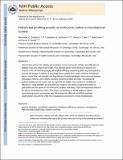Poly(A)-tail profiling reveals an embryonic switch in translational control
Author(s)
Subtelny, Alexander Orest; Eichhorn, Stephen William; Chen, Grace; Sive, Hazel L.; Bartel, David
DownloadBartel_Poly(a)-tail.pdf (1.809Mb)
PUBLISHER_POLICY
Publisher Policy
Article is made available in accordance with the publisher's policy and may be subject to US copyright law. Please refer to the publisher's site for terms of use.
Terms of use
Metadata
Show full item recordAbstract
Poly(A) tails enhance the stability and translation of most eukaryotic messenger RNAs, but difficulties in globally measuring poly(A)-tail lengths have impeded greater understanding of poly(A)-tail function. Here we describe poly(A)-tail length profiling by sequencing (PAL-seq) and apply it to measure tail lengths of millions of individual RNAs isolated from yeasts, cell lines, Arabidopsis thaliana leaves, mouse liver, and zebrafish and frog embryos. Poly(A)-tail lengths were conserved between orthologous mRNAs, with mRNAs encoding ribosomal proteins and other ‘housekeeping’ proteins tending to have shorter tails. As expected, tail lengths were coupled to translational efficiencies in early zebrafish and frog embryos. However, this strong coupling diminished at gastrulation and was absent in non-embryonic samples, indicating a rapid developmental switch in the nature of translational control. This switch complements an earlier switch to zygotic transcriptional control and explains why the predominant effect of microRNA-mediated deadenylation concurrently shifts from translational repression to mRNA destabilization.
Date issued
2014-01Department
Harvard University--MIT Division of Health Sciences and Technology; Massachusetts Institute of Technology. Department of BiologyJournal
Nature
Publisher
Nature Publishing Group
Citation
Subtelny, Alexander O., Stephen W. Eichhorn, Grace R. Chen, Hazel Sive, and David P. Bartel. “Poly(A)-Tail Profiling Reveals an Embryonic Switch in Translational Control.” Nature 508, no. 7494 (January 29, 2014): 66–71.
Version: Author's final manuscript
ISSN
0028-0836
1476-4687